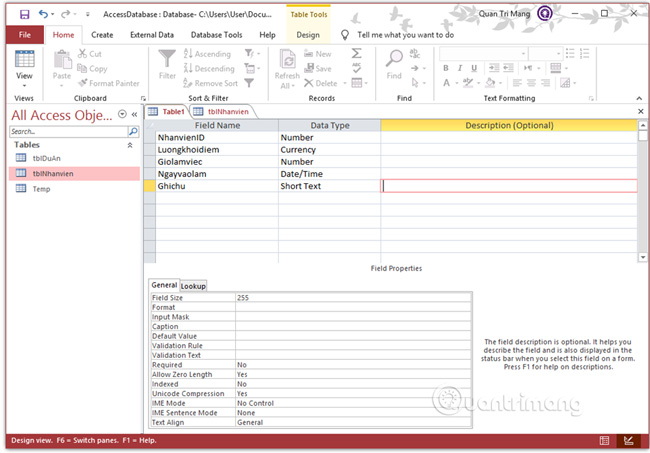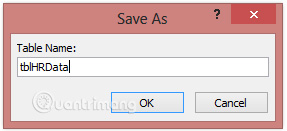Establish relationships between tables in Access 2016
In this article, TipsMake.com will work with you to learn the necessity of creating relationships between related tables. The relationship between tables is the data link between tables. By defining these relationships, you can drag records from related tables based on the fields of each table.
One of the good database design goals is to eliminate data redundancy.
- To achieve that goal, you need to divide your data into multiple tables on multiple topics so that each entity is interpreted only once.
- To do this, all related fields will be placed in a table.
- To perform this step correctly, you must first understand the relationship between your tables and then specify these relationships in your Access database.
Why should relations be established between tables?
MS Access uses relationships to join tables that help you use them in a database object. You should create table relationships before you create other database objects such as forms, queries, macros, reports, and reasons like this:
- To work with records from two or more tables, you often have to create a query with the participation of multiple tables.
- The query works by matching the values in the first primary key field of the table with the foreign key in the second table.
- When designing forms or reports, MS Access uses the information collected from defined table relationships to provide appropriate choices.
- When designing databases, you divide your data into multiple tables by multiple topics, each with a primary key and then add foreign keys to the relevant tables. Main key pairs - foreign key is the basis for table relationships and query multiple tables.
Now let's add another table of personnel information to your database and name it tblHRData with Table Design as shown in the following screenshot.

Next, save and name this table.

Now we have an extra table. In the next lessons, Quantrimang will go into specific examples of setting up each type of relationship . You keep watching!
Previous article: Standardizing databases in Access - Relationships between tables
Next lesson: 1-1 relationship between tables in ACCESS
You should read it
- Relationships between tables in Access
- 1-1 relationship between tables in ACCESS
- 14 questions you need to answer before starting a new relationship
- Work with data in Access 2016
- Edit tables in Access 2016
- 1-n relationship between tables in Access
- How to improve relationships in just 60 seconds?
- Steps to export Microsoft Access data to Word documents
May be interested
- MS Access 2003 - Lesson 39: Analyzing tables
 access includes a very powerful tool that you can use to analyze data in one or more tables.
access includes a very powerful tool that you can use to analyze data in one or more tables. - MS Access 2003 - Lesson 15: Create an initial table
 in this section, you are ready to create a table for the new database. in chapter 2, you used the table wizard to create tables easily. this not only shows that creating a table manually is difficult; but it is a sure way to understand the table.
in this section, you are ready to create a table for the new database. in chapter 2, you used the table wizard to create tables easily. this not only shows that creating a table manually is difficult; but it is a sure way to understand the table. - Work with data in Access 2016
 in the previous lesson, you became familiar with the access 2016 interface as well as the opening and closing of the basic database. this article will continue to go deeper into access 2016 around the content of working with data in access 2016.
in the previous lesson, you became familiar with the access 2016 interface as well as the opening and closing of the basic database. this article will continue to go deeper into access 2016 around the content of working with data in access 2016. - MS Access 2003 - Lesson 12: Working with a table
 you have learned how to create and design tables in access. and now it's time to learn how to manipulate all tables.
you have learned how to create and design tables in access. and now it's time to learn how to manipulate all tables. - Create data queries in Access 2016 from simple to complex
 the query allows to retrieve information from one or more tables based on the search conditions you defined. in this lesson, you will learn how to create queries on a simple table and query on multiple tables in access 2016.
the query allows to retrieve information from one or more tables based on the search conditions you defined. in this lesson, you will learn how to create queries on a simple table and query on multiple tables in access 2016. - How to Link Tables in Access
 microsoft access allows tables and databases to connect with each other. this capability can increase your efficiency and easily spread information that is required for multiple departments or reports. you can make changes in the original...
microsoft access allows tables and databases to connect with each other. this capability can increase your efficiency and easily spread information that is required for multiple departments or reports. you can make changes in the original... - MS Access 2003 - Lesson 8: Change information in the table
 in the previous section, you learned how to use the datasheet view mode to enter information for the table. the datasheet view mode also allows you to edit available information quickly and easily.
in the previous section, you learned how to use the datasheet view mode to enter information for the table. the datasheet view mode also allows you to edit available information quickly and easily. - Advantages of MongoDB
 any relation database has a unique schema design to index the data tables and relationships between those tables. meanwhile in mongodb there is no concept of relationship.
any relation database has a unique schema design to index the data tables and relationships between those tables. meanwhile in mongodb there is no concept of relationship. - How to fix errors Can't Establish Secure Connection on Safari
 if you have a problem can't establish secure connection when browsing frequently visited websites on safari, read the following article to find out how to fix it.
if you have a problem can't establish secure connection when browsing frequently visited websites on safari, read the following article to find out how to fix it. - Table in CSS
 tables in html can become much more beautiful thanks to css.
tables in html can become much more beautiful thanks to css.










 Tips to reduce the size of PowerPoint files should be known
Tips to reduce the size of PowerPoint files should be known Standardize databases in Access - Relationships between tables
Standardize databases in Access - Relationships between tables How to design business cards in Microsoft Word
How to design business cards in Microsoft Word Alternate Criteria in Access 2016
Alternate Criteria in Access 2016 Insert brackets in Word, Excel
Insert brackets in Word, Excel How to transfer Google Docs to Word
How to transfer Google Docs to Word